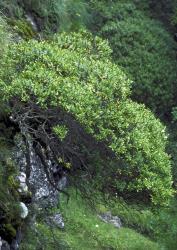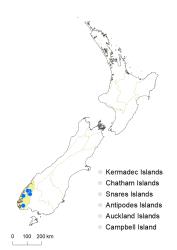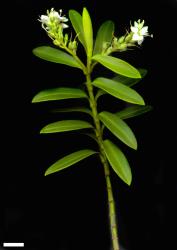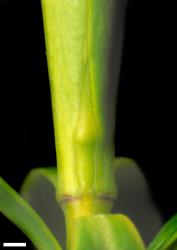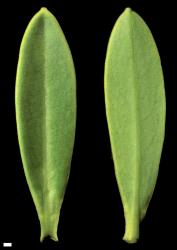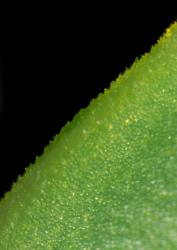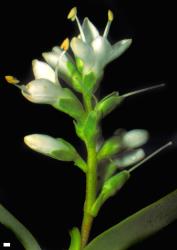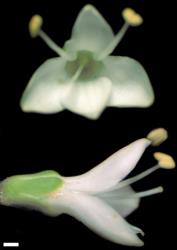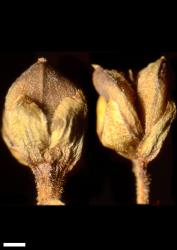- ≡ Hebe arganthera Garn.-Jones, Bayly, W.G.Lee & Rance, New Zealand J. Bot. 38: 380 (2000)
Bushy shrub to 1.5 m tall. Stems ascending to erect, or old ones hanging on cliffs; eglandular-pubescent, hairs bifarious. Leaf bud distinct, its outer leaves fully grown, appressed at margins; sinus narrowly acute. Leaves opposite-decussate, erecto-patent to spreading; lamina sub-coriaceous to coriaceous, narrowly elliptic, oblong, or oblanceolate, 12–38 mm long, 5–11 mm wide, dull green or yellowish-green above, dull pale green beneath; midrib evident; surfaces glabrous except for eglandular hairs along midrib above; margin ciliolate or papillate or rarely ciliate, entire; apex sub-acute, plicate-acuminate; base cuneate; petiole 3–4 mm long. Inflorescence a lateral raceme sometimes with 1–2 branches at base, 20–50 mm long; flowers crowded, 9–25, all bisexual; bracts opposite, sometimes becoming alternate above, linear, lanceolate, or narrowly deltoid, ≥ pedicels; pedicels erecto-patent, 0.5–5.0 mm long, eglandular-pubescent all around. Calyx lobes 4, obtuse, 2.2–2.8 mm long, equal, eglandular-ciliolate or mixed glandular- and eglandular-ciliolate. Corolla 7–9 mm diameter; tube white, 1.5–2.5 mm long, ≤ calyx, glabrous; lobes 4, white, erecto-patent to recurved, sub-equal, deltoid or broadly ovate to broadly elliptic, 4.5–6.0 mm long, obtuse; nectar guides absent. Stamen filaments white, 4.0–6.5 mm long; anthers white or pale yellow. Style glabrous, 5–7 mm long. Capsules latiseptate, acute, glabrous, 3–4 mm long, 2.5–3.5 mm at widest point. Seeds discoid to ellipsoid, flattened, smooth, straw-yellow to pale brown, 0.5–0.9 mm long.
V. arganthera has some characteristic features not covered in the above description: prominent leaf base scars on the stems, giving them a rough appearance, and the petiole is hairy above and beneath. The plants look superficially similar to V. subalpina, but plants of V. subalpina differ in their glossy, bright green leaves, glabrous leaf margins, absence of a sinus in the leaf bud, and magenta anthers. In southern New Zealand, V. cockayneana and V. dilatata are similar in having a narrowly acute sinus in the vegetative bud, but plants of either may be distinguished from V. arganthera by their smaller, more glaucous or glaucescent leaves (discolorous and sometimes glandular-ciliate in V. cockayneana) and magenta anthers.
South Island: Fiordland (Lake Wapiti, Takahe Valley, Doubtful Sound above Kellard Point, Lake Monk). Additional to vouchered location records is a photographic record from c. 500 m north-west of Evans Peak, Bradshaw Sound, on karst limestone, not included on the map.
Calcareous bluffs and steep slopes near and above tree line. Recorded elevations range from 840 to 1600 m.
Flowers: December–January (extending to May); fruits: March (probably also earlier and later).
2n = 40 (see Bayly & Kellow 2006, as Hebe arganthera).
Veronica arganthera is classified in V. subg. Pseudoveronica sect. Hebe and the informal group “Apertae” (small-leaved) (Albach & Meudt 2010; Bayly & Kellow 2006).



